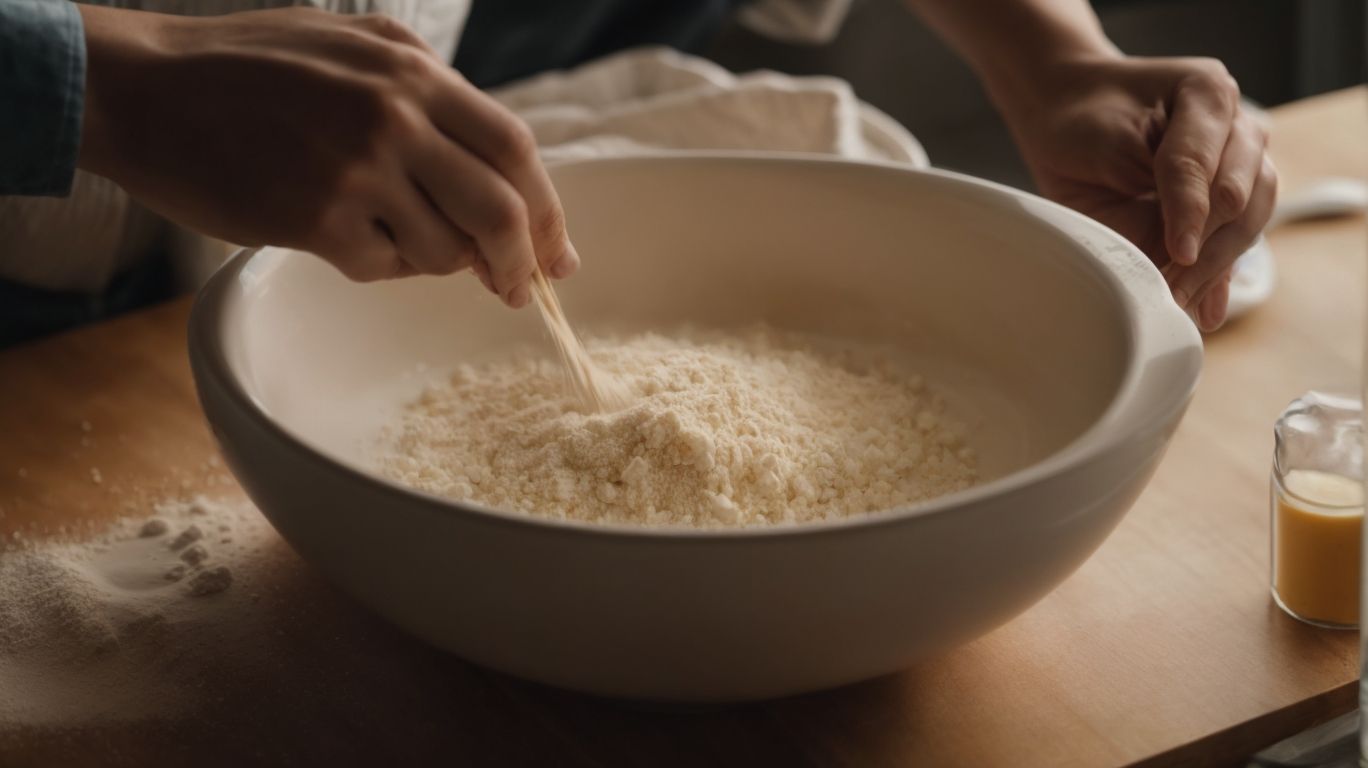How to Bake Bread Without Kneading?
Looking to bake delicious bread with minimal effort?
Discover the popular trend of No-Knead Bread. We explore the history and benefits of No-Knead Bread, the essential ingredients and tools needed, step-by-step instructions for making it at home, and some tips and tricks for perfect results.
If you’re ready to learn how to make mouthwatering bread without all the hard work, keep reading!
Key Takeaways:
What is No-Knead Bread?
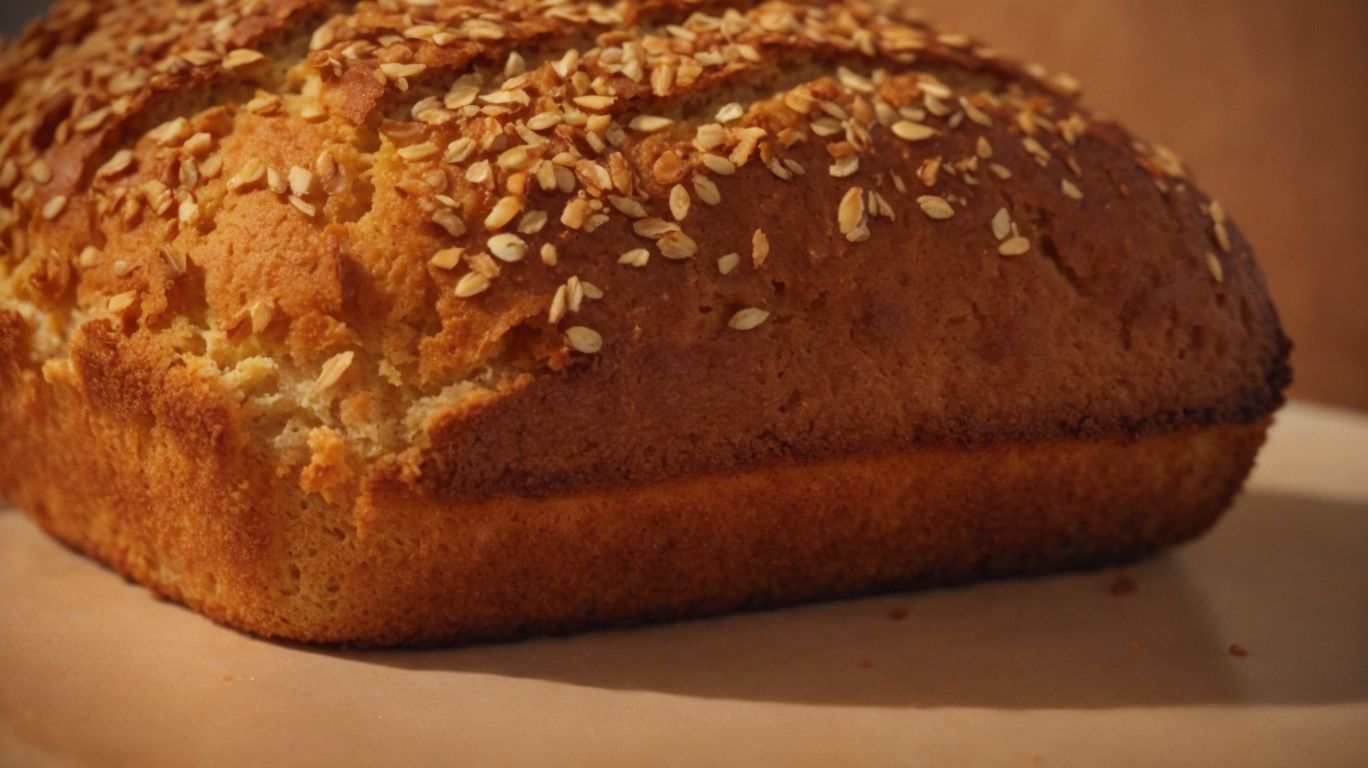
Credits: Poormet.Com – Matthew Wilson
No-Knead Bread is a type of bread that requires minimal effort in the kneading process, resulting in a rustic and artisanal loaf with a crispy crust and soft interior.
This bread recipe has gained popularity for its simplicity and foolproof method that even novice bakers can master. One of the key advantages of the no-knead bread technique is that it allows the dough to ferment slowly over an extended period, developing complex flavors and a chewy texture. By eliminating the kneading process, the bread maintains a unique open crumb structure, ideal for capturing butter, jams, or other toppings.
History of No-Knead Bread
The History of No-Knead Bread traces back to baker Jim Lahey, who popularized the method through his traditional recipe that revolutionized home baking with minimal yeast and extended fermentation periods.
Lahey’s technique gained widespread recognition after a feature in The New York Times in 2006, sparking a worldwide interest in artisanal bread-making. This simple yet revolutionary approach resonated with home bakers seeking an easy way to achieve professional-quality bread at home. The idea behind no-knead bread is to allow time and fermentation to develop the gluten structure in the dough naturally. As a result, the bread boasts a complex flavor profile and an airy, hole-riddled crumb reminiscent of traditional European loaves.
Benefits of No-Knead Bread
The Benefits of No-Knead Bread include simplicity, enhanced flavor development, and the convenience of a faster version that allows for homemade baking experiences without extensive kneading.
One of the key advantages of baking No-Knead Bread is its accessibility – even novice bakers can achieve professional results with minimal effort. The beauty of this technique lies in the long fermentation period, which helps develop complex flavors naturally. This results in a rich, aromatic loaf that rivals those found in artisanal bakeries.
The hands-off approach of No-Knead Bread recipes appeals to busy individuals who still crave the satisfaction of creating a beautiful, crusty bread at home. The simplicity of the process allows for customization – from adding seeds and nuts to experimenting with different flours, the possibilities are endless.
Ingredients for No-Knead Bread
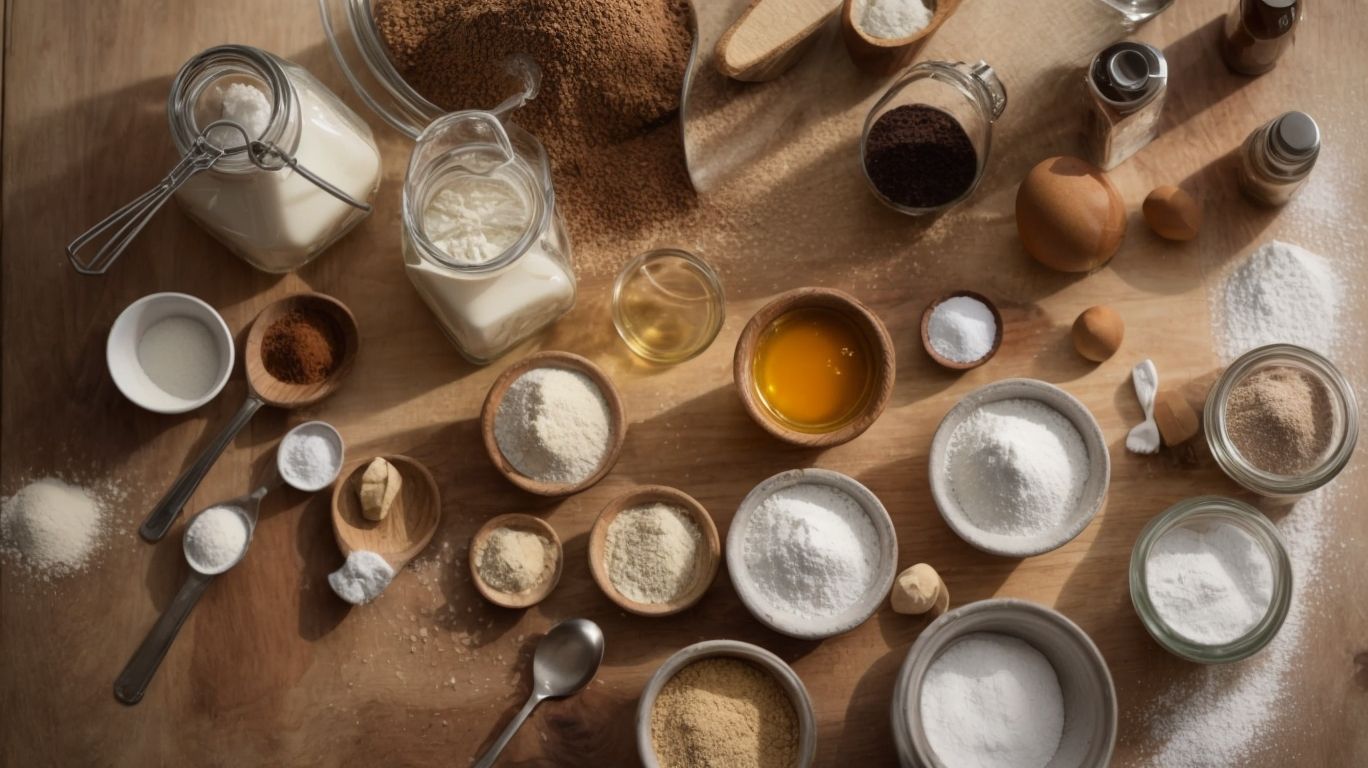
Credits: Poormet.Com – Steven Jones
The key Ingredients for No-Knead Bread are flour, yeast, salt, and water, which form the foundation of this simple yet flavorful bread recipe.
Starting with flour, it is the primary structure-builder; it provides the basic framework and texture of the bread. The flour also serves as the main source of carbohydrates, essential for the fermentation process. Yeast, a living organism, interacts with sugars in the flour to create carbon dioxide, responsible for the bread’s rise. Meanwhile, salt enhances the flavor by balancing sweetness and suppressing yeast activity, contributing to the dough’s texture. Lastly, water acts as the hydrating agent that activates gluten formation, resulting in the bread’s structure.
Flour
Flour is a fundamental ingredient in No-Knead Bread, with traditional options like all-purpose flour or whole wheat flour providing the base for crafting rustic and no-knead artisan loaves.
In terms of choosing the right flour for your no-knead bread, different types offer unique characteristics.
- All-purpose flour, with its moderate protein content, gives a balanced structure and crumb to the bread.
- On the other hand, whole wheat flour adds a nutty flavor and a denser texture to the loaf.
- For those looking to experiment, bread flour provides a chewier consistency.
- Semolina flour offers a golden hue and a slightly coarser crumb.
Yeast
Yeast plays a crucial role in No-Knead Bread recipes, facilitating the fermentation process that develops the dough’s structure and imparts a rich flavor to the final loaf.
The fermentation process initiated by yeast is what truly sets No-Knead Bread apart, as it allows for the dough to rise naturally without the need for extensive kneading. Yeast, a microscopic fungus, consumes sugars in the dough and produces carbon dioxide gas, creating those lovely air pockets that give the bread its airy texture. This slow fermentation process not only enhances the flavor but also improves the texture of the bread, resulting in a chewy crumb and a crisp crust that’s hard to resist.
Salt
Salt is a critical component in No-Knead Bread, not only enhancing the flavor profile of the dough but also regulating the fermentation process and supporting gluten development.
When added to the dough, salt helps to strengthen the gluten structure, resulting in a better crumb texture and improved rise. Salt plays a crucial role in controlling the fermentation process by regulating yeast activity, ensuring a balanced and controlled growth. This not only impacts the dough’s consistency but also enhances the overall flavor of the bread.
Moreover, salt helps to slow down enzymatic activity during fermentation, allowing for a longer, more flavor-developing process. Its presence also assists in controlling the rate of fermentation, ultimately contributing to a more manageable and predictable dough-making experience.
Water
Water serves as the primary liquid component in No-Knead Bread recipes, hydrating the flour, activating the yeast, and contributing to the dough’s texture and consistency.
Hydration of the flour by water is crucial as it allows the gluten in the dough to develop, resulting in a well-structured bread. Proper hydration ensures that the yeast, responsible for leavening, can ferment effectively, leading to a light and airy final product. Water plays a vital role in temperature control during the dough preparation, influencing the fermentation process and ultimately the flavor profile of the bread. So, choosing the right quality and quantity of water is key for successful No-Knead Bread making.
Tools Needed for No-Knead Bread
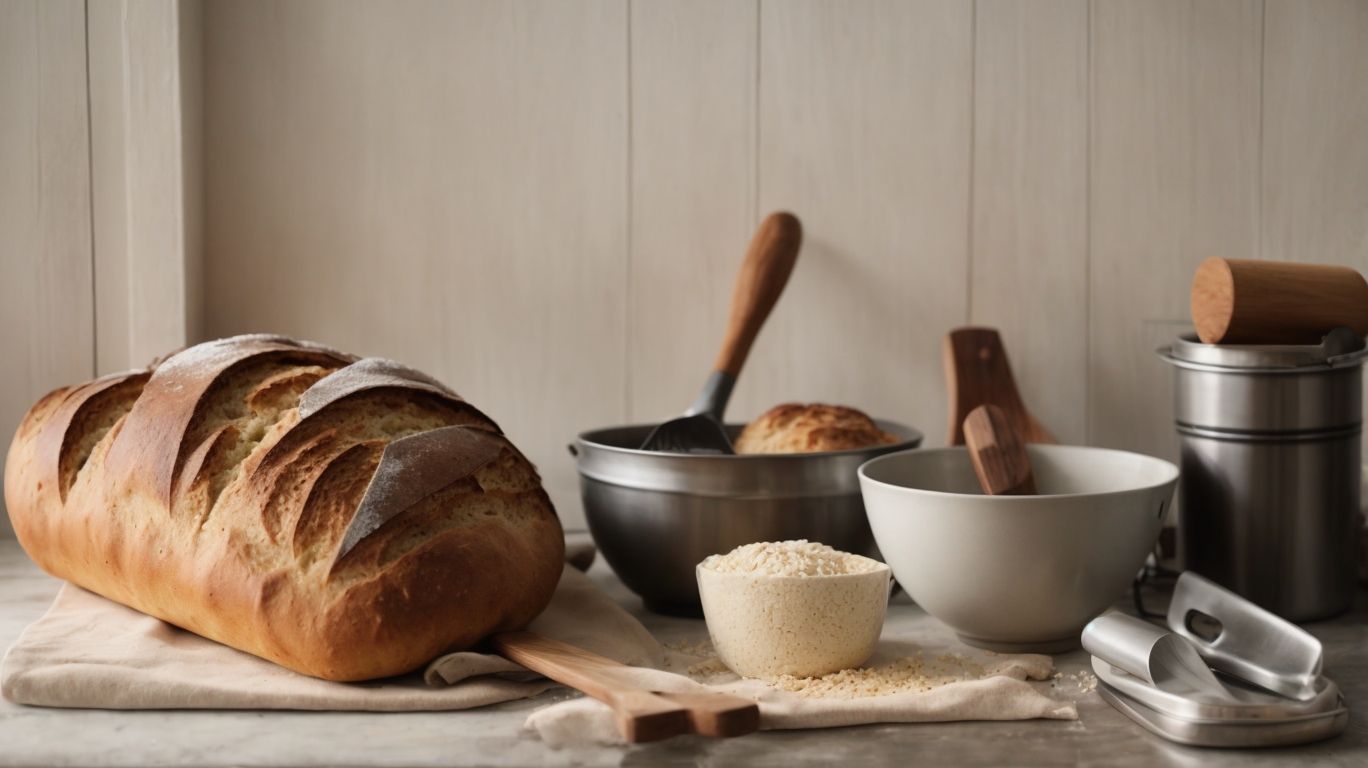
Credits: Poormet.Com – Gabriel Lewis
To make No-Knead Bread successfully, essential Tools like a Dutch oven, mixing bowl, and parchment paper are required to ensure proper dough development and optimal baking results.
The Dutch oven plays a crucial role in creating the perfect crust by trapping steam inside during baking, resulting in a crispy exterior.
A well-sized mixing bowl allows for easy kneading, shaping, and rising of the dough.
Parchment paper comes in handy for easy transfer of the dough and prevents sticking, ensuring a smooth baking process.
These tools are essential in the world of bread making, simplifying the entire process and elevating the final product to perfection.
Dutch Oven
A Dutch oven is an essential tool for baking No-Knead Bread, creating the ideal environment for achieving a crispy crust and ensuring proper heat distribution during the baking process.
In terms of No-Knead Bread, achieving that perfect golden crust can be a challenge, but a Dutch oven simplifies the task. The heavy lid of a Dutch oven traps steam released from the bread dough, mimicking the effects of a professional steam-injected oven. This steam helps in the crust development, giving it the desired crispiness and beautiful color, characteristics that are often hard to achieve in home ovens. Plus, a Dutch oven’s thick walls aid in heat retention, ensuring that your bread bakes evenly and with a superior crumb structure.
Mixing Bowl
A Mixing Bowl is essential for preparing the No-Knead Bread dough, allowing for proper mixing, fermentation, and rise of the ingredients to achieve a light and airy texture in the final loaf.
In terms of making No-Knead Bread, the mixing bowl plays a crucial role in bringing together the key components of flour, water, yeast, and salt in a harmonious blend. This vessel acts as the stage where the magic of fermentation occurs, as the gluten strands develop and trap air bubbles, leading to that coveted airy crumb structure in your bread.
Using a mixing bowl helps in controlling the consistency of the dough, ensuring that the hydration levels are just right for optimal fermentation and rise. It allows for easy incorporation of ingredients, promoting the formation of a cohesive dough without the need for strenuous kneading, which is the hallmark of no-knead recipes.
The size and shape of the mixing bowl are also crucial factors to consider. A spacious bowl provides room for the dough to expand during fermentation and rise, preventing any spillovers and allowing for proper aeration. The material of the bowl, whether glass, ceramic, or stainless steel, can also impact the dough’s temperature regulation during the fermentation process, influencing the overall fermentation rate and flavor development.
In essence, the humble mixing bowl is not just a vessel for holding ingredients; it is a key player in the alchemical process of turning simple elements into a flavorful, complex loaf of No-Knead Bread.
Wooden Spoon
A Wooden Spoon is a versatile Tool for mixing and handling No-Knead Bread dough, allowing for gentle incorporation of ingredients without overworking the mixture and ensuring proper fermentation.
In terms of making No-Knead Bread, the delicate balance of combining the flour, water, salt, and yeast is crucial for a successful outcome. This is where the Wooden Spoon shines, as its smooth surface and gentle nature make it ideal for gradually mixing the ingredients together in a way that doesn’t disrupt the formation of gluten strands. By using a Wooden Spoon, you can avoid the temptation to overmix the dough, which can result in a dense and tough final product.
Parchment Paper
Parchment Paper is a useful accessory for shaping and transferring No-Knead Bread dough, preventing sticking, and facilitating easy removal of the baked loaf for a seamless baking experience.
When you utilize parchment paper in your No-Knead Bread baking, you not only eliminate the need for excessive flour or oil to prevent sticking but also ensure that the dough retains its perfect shape during the rising and baking process. The non-stick properties of parchment paper make it a breeze to transfer the dough without any messy residue left behind. In terms of handling the finished loaf, parchment paper allows for effortless lifting and serving, ensuring that your bread comes out of the oven looking and tasting its best.
Step-by-Step Instructions for Making No-Knead Bread
Follow these Step-by-Step Instructions to craft a delicious No-Knead Bread with a crispy crust, soft crumb, and a tantalizing aroma that will elevate your baking experience.
Begin by combining flour, yeast, salt, and water in a large mixing bowl, stirring until a shaggy dough forms. Cover the bowl with plastic wrap and let it rest at room temperature for around 12-18 hours to allow for dough rising and development of complex flavors.
Once the dough has doubled in size and is dotted with bubbles, transfer it onto a well-floured surface, folding it a few times to shape it into a round loaf. Place the dough seam side down in a preheated Dutch oven and bake covered for 30 minutes to create steam for a crisp crust, then uncover and bake for an additional 15 minutes for that perfect golden hue. Let the loaf cool before slicing and enjoying the fruits of your labor.
Mixing the Ingredients
The first Step in making No-Knead Bread involves gently Mixing the Ingredients to form a shaggy dough that will develop into a flavorful and aromatic loaf during the fermentation process.
When mixing the ingredients for No-Knead Bread, it is crucial to use a gentle hand to avoid overworking the dough. Start by combining the flour, salt, yeast, and water in a large mixing bowl. Using a wooden spoon or spatula, stir the ingredients together just until they are fully incorporated.
Avoid the temptation to knead the dough as the goal here is to allow the gluten to develop naturally over time through a slow fermentation process. The shaggy texture of the dough at this stage is completely normal and will transform beautifully during the resting period.
Letting the Dough Rest
Allow the No-Knead Bread Dough to Rest for an extended period, preferably overnight, to facilitate a slow fermentation process that enhances flavor development and promotes a light and airy texture in the final loaf.
During the resting period, the dough undergoes a transformative process where the yeast works its magic, breaking down complex sugars into simpler ones, resulting in a more flavorful bread. This slow fermentation also allows the gluten structure to develop naturally, giving the bread its characteristic airy crumb.
As the dough rests, it goes through different rise stages, starting with the initial proofing where the yeast becomes activated, leading to the production of carbon dioxide bubbles that make the dough rise.
Subsequent rise stages contribute to the overall texture of the bread, creating those desirable air pockets and a soft, chewy crumb that is a hallmark of well-made artisanal bread.
Baking the Bread
Bake the prepared No-Knead Bread Dough in a preheated oven to achieve a golden crust, tender crumb, and irresistible aroma that signals the completion of a successful bread-making journey.
-
When the oven reaches the desired temperature, carefully place the dough into a preheated Dutch oven or a baking stone.
-
Ensure the oven is adequately preheated to promote proper oven spring, a crucial step in creating that desirable airy crumb.
-
During the initial stage of baking, covering the bread helps trap steam, facilitating crust formation while retaining moisture for a soft interior.
-
For the last few minutes, remove the cover to allow the crust to develop its characteristic deep color and a slight crunch.
Tips and Tricks for Perfect No-Knead Bread
Enhance your No-Knead Bread baking skills with these invaluable Tips and Tricks that will simplify the process, elevate your loaves, and ensure consistent results using a Dutch oven for optimal outcomes.
One key element in achieving perfect No-Knead Bread is the proper fermentation of the dough. Allow your dough to rest for an adequate amount of time to develop flavor and texture. Additionally, proper hydration of the dough is crucial for a soft crumb and a crispy crust.
To troubleshoot common issues like a dense crumb or lack of rise, ensure your yeast is fresh and active. Room temperature also plays a vital role in yeast activation.
Using a Dutch oven for baking creates the ideal steamy environment, promoting oven spring and a caramelized crust. The magic of a Dutch oven lies in its ability to retain heat and create a mini steam chamber.
FAQs about No-Knead Bread
Explore these FAQs to address common queries about No-Knead Bread, including tips on adding flavor variations like garlic, fresh herbs, rosemary, and black pepper to customize your artisanal loaves.
One popular method of enhancing the flavor of your No-Knead Bread is by incorporating a mix of different herbs and spices. For instance, you can try adding a blend of thyme, oregano, and basil to introduce a Mediterranean twist. Mixing in sun-dried tomatoes or olives can bring a savory depth to your loaf. Experiment with seeds and nuts like sesame seeds, pumpkin seeds, or walnuts to add crunch and nuttiness. These additions not only elevate the taste but also create a visually appealing, textured crust.
Can I Use Different Types of Flour?
Yes, you can experiment with Different Types of Flour in your No-Knead Bread recipes, such as traditional all-purpose flour or specialty varieties like Italian seasoning-infused flour to introduce unique flavors and textures.
When choosing the perfect flour for your no-knead bread, consider the impact it will have on the final product. Whole wheat flour, for example, can add a nutty flavor and denser texture, perfect for hearty loaves. Conversely, using a blend of rye flour can bring a deeper complexity to the bread with a hint of earthiness.
If you’re looking to elevate the taste profile even more, experimenting with spelt flour or buckwheat flour could offer a slightly sweet and nutty undertone. These alternative flours can also enhance the nutritional value of your bread by introducing different grains into the mix.
How Can I Add Flavor to No-Knead Bread?
You can enhance the Flavor of your No-Knead Bread by incorporating ingredients like garlic, black pepper, or aromatic Herbs de Provence, creating a personalized taste profile that elevates your homemade loaves.
Experiment with different combinations of fresh or dried herbs such as rosemary, thyme, or oregano to infuse your bread with a Mediterranean flair. Sprinkle some parmesan cheese on top before baking for a savory twist, or add a touch of honey for a subtle sweetness. For a spicy kick, try mixing in cayenne pepper or paprika. Incorporating olives, sun-dried tomatoes, or even caramelized onions can add depth and complexity to the flavor profile of your bread.
Can I Make No-Knead Bread Gluten-Free?
Yes, you can create a Gluten-Free version of No-Knead Bread by using alternative flours like almond flour or gluten-free blends, along with natural sweeteners like honey for added moisture and flavor.
When substituting all-purpose flour with almond flour or a gluten-free mix, ensure you adjust the liquid ratio accordingly to achieve the right dough consistency.
Honey plays a crucial role in gluten-free baking by adding moisture to compensate for the lack of gluten structure, resulting in a softer texture.
Experiment with different gluten-free flours and starches such as rice flour, tapioca flour, or potato starch to find the right combination for your Gluten-Free No-Knead Bread.
Remember not to overmix the dough as it can affect the final texture of the bread.
Conclusion
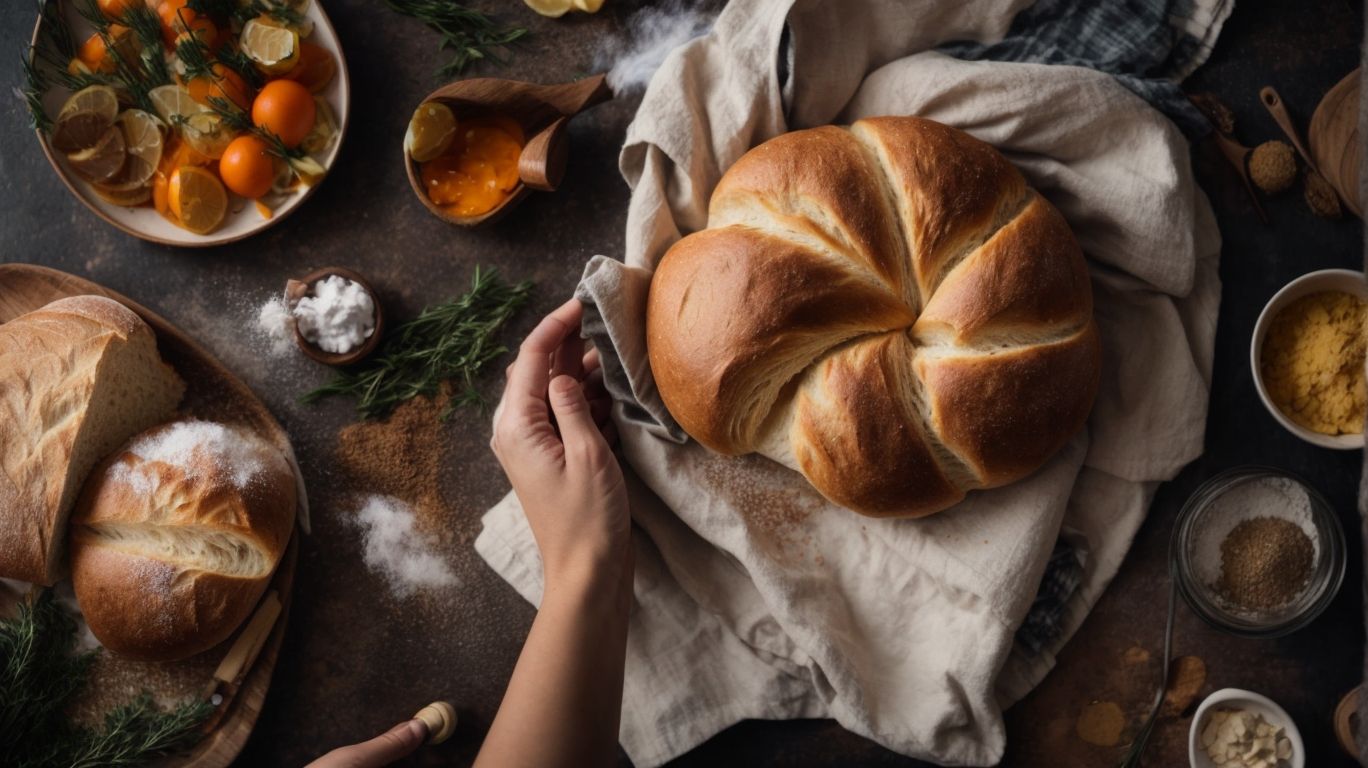
Credits: Poormet.Com – Dennis Rivera
In conclusion, No-Knead Bread offers a delightful journey into the realm of homemade artisanal baking, providing a simple yet rewarding recipe for crafting delicious loaves with minimal effort and maximum flavor.
No-Knead Bread has gained immense popularity among home bakers due to its appeal of creating professional-quality artisanal loaves without the need for tedious kneading. With this method, the dough undergoes a long fermentation process, resulting in a crusty exterior and an airy, hole-filled interior that rivals bakery-made breads. The beauty of No-Knead Bread lies in its simplicity; flour, water, salt, and yeast are combined and left to ferment for an extended period, transforming basic ingredients into a flavorful masterpiece.
Frequently Asked Questions
How to Bake Bread Without Kneading?
The traditional method of baking bread involves kneading the dough for several minutes, but this can be time-consuming and tiring. Luckily, there are alternative methods for making delicious bread without kneading.
Can I still achieve a soft and fluffy texture without kneading?
Absolutely! Kneading helps develop gluten in the dough, but there are other techniques that can also achieve a soft and fluffy texture, such as using a long fermentation process or incorporating a higher hydration ratio.
What ingredients do I need for no-knead bread?
The basic ingredients for no-knead bread are flour, water, salt, and yeast. You can also add in other ingredients like herbs, nuts, or dried fruits to give your bread extra flavor and texture.
How long does it take to bake bread without kneading?
The time it takes to bake bread without kneading will vary depending on the specific recipe and technique used. However, most no-knead bread recipes will require a longer fermentation period, usually around 12-18 hours, so plan ahead.
Can I use a bread machine to make no-knead bread?
While bread machines are designed for kneading dough, they can also be used to make no-knead bread. Simply mix all the ingredients in the bread machine, let it go through the kneading and rising cycles, then take the dough out and bake it in the oven.
Is it possible to make no-knead bread in a Dutch oven?
Yes, using a Dutch oven is a popular and effective way to bake no-knead bread. The Dutch oven traps steam during baking, creating a crispy crust and a soft interior. Just make sure your Dutch oven is oven-safe and preheated before adding the dough.

